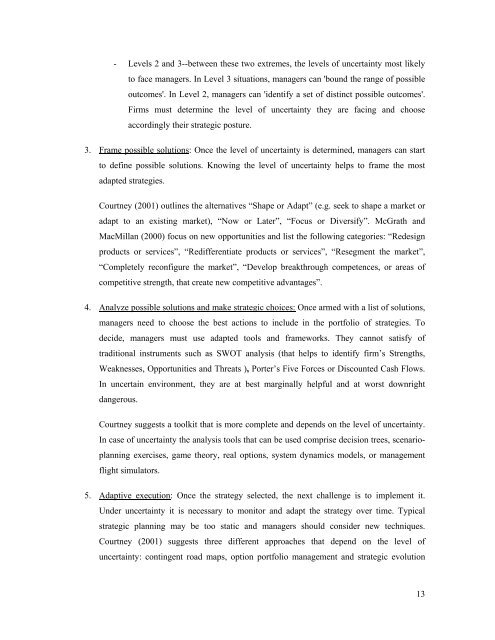Managing Risks of Supply-Chain Disruptions: Dual ... - CiteSeerX
Managing Risks of Supply-Chain Disruptions: Dual ... - CiteSeerX
Managing Risks of Supply-Chain Disruptions: Dual ... - CiteSeerX
You also want an ePaper? Increase the reach of your titles
YUMPU automatically turns print PDFs into web optimized ePapers that Google loves.
- Levels 2 and 3--between these two extremes, the levels <strong>of</strong> uncertainty most likelyto face managers. In Level 3 situations, managers can 'bound the range <strong>of</strong> possibleoutcomes'. In Level 2, managers can 'identify a set <strong>of</strong> distinct possible outcomes'.Firms must determine the level <strong>of</strong> uncertainty they are facing and chooseaccordingly their strategic posture.3. Frame possible solutions: Once the level <strong>of</strong> uncertainty is determined, managers can startto define possible solutions. Knowing the level <strong>of</strong> uncertainty helps to frame the mostadapted strategies.Courtney (2001) outlines the alternatives “Shape or Adapt” (e.g. seek to shape a market oradapt to an existing market), “Now or Later”, “Focus or Diversify”. McGrath andMacMillan (2000) focus on new opportunities and list the following categories: “Redesignproducts or services”, “Redifferentiate products or services”, “Resegment the market”,“Completely reconfigure the market”, “Develop breakthrough competences, or areas <strong>of</strong>competitive strength, that create new competitive advantages”.4. Analyze possible solutions and make strategic choices: Once armed with a list <strong>of</strong> solutions,managers need to choose the best actions to include in the portfolio <strong>of</strong> strategies. Todecide, managers must use adapted tools and frameworks. They cannot satisfy <strong>of</strong>traditional instruments such as SWOT analysis (that helps to identify firm’s Strengths,Weaknesses, Opportunities and Threats ), Porter’s Five Forces or Discounted Cash Flows.In uncertain environment, they are at best marginally helpful and at worst downrightdangerous.Courtney suggests a toolkit that is more complete and depends on the level <strong>of</strong> uncertainty.In case <strong>of</strong> uncertainty the analysis tools that can be used comprise decision trees, scenarioplanningexercises, game theory, real options, system dynamics models, or managementflight simulators.5. Adaptive execution: Once the strategy selected, the next challenge is to implement it.Under uncertainty it is necessary to monitor and adapt the strategy over time. Typicalstrategic planning may be too static and managers should consider new techniques.Courtney (2001) suggests three different approaches that depend on the level <strong>of</strong>uncertainty: contingent road maps, option portfolio management and strategic evolution13
















